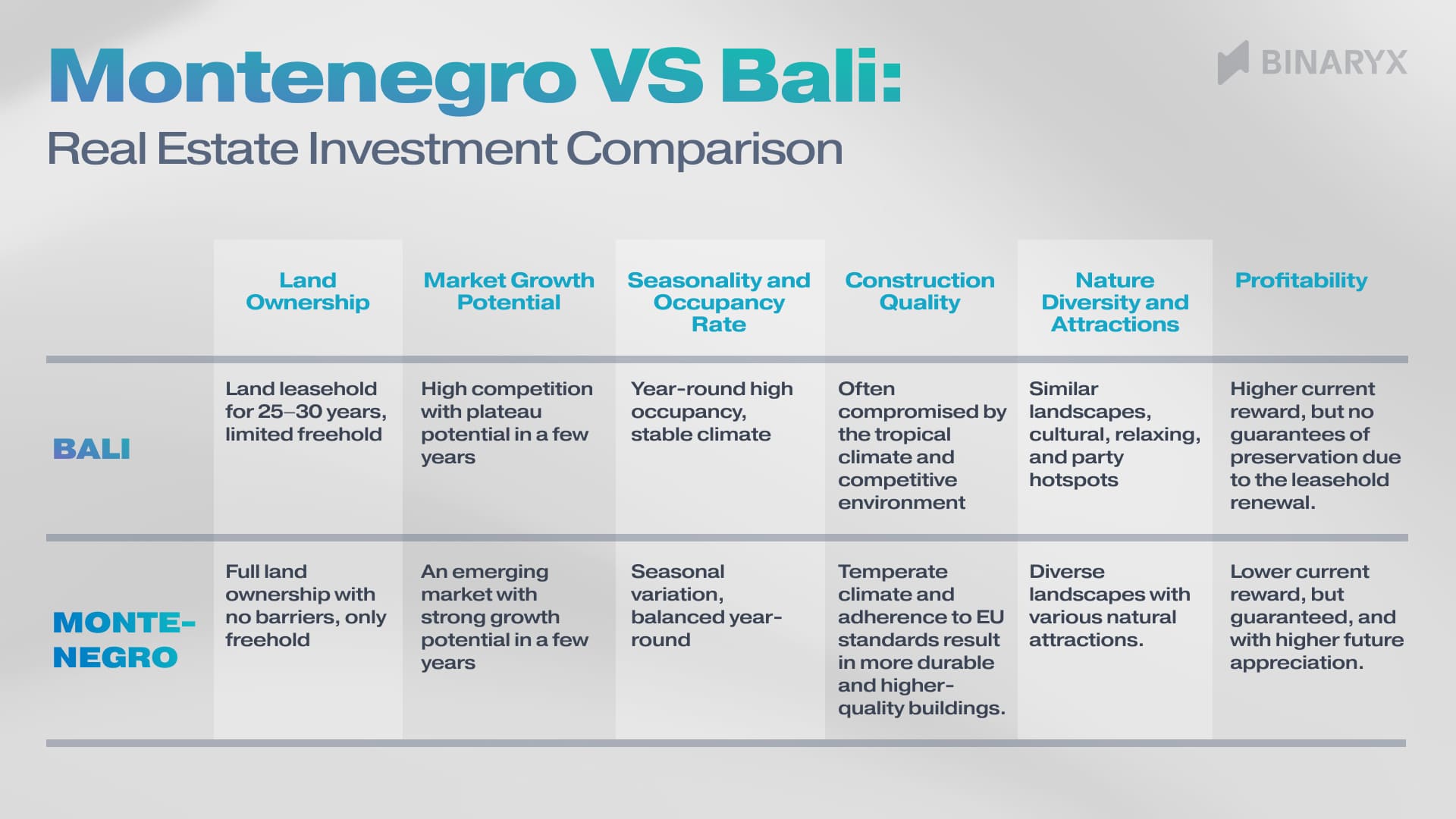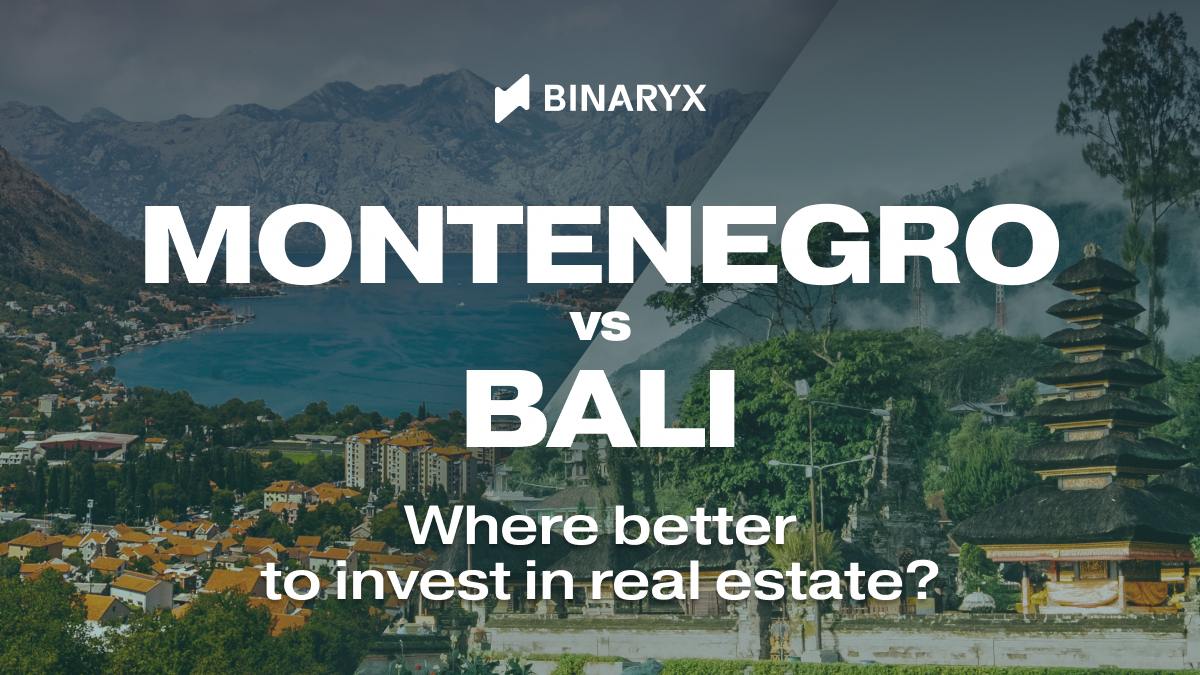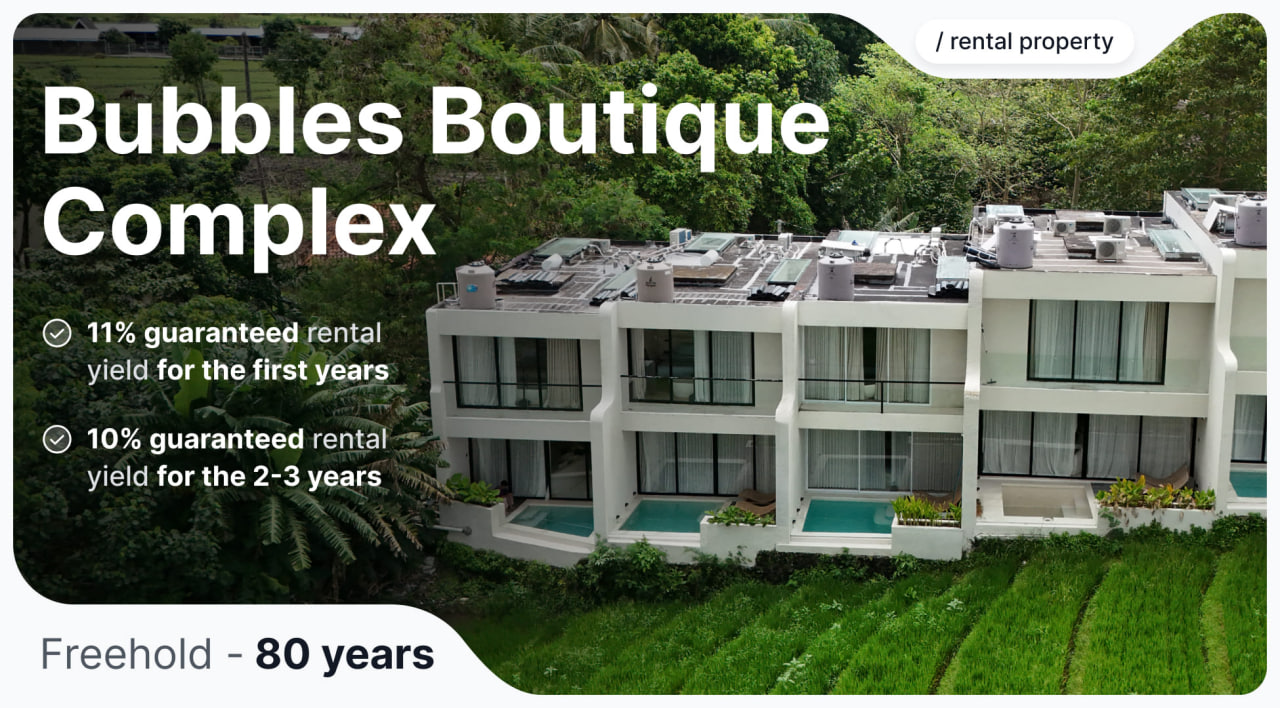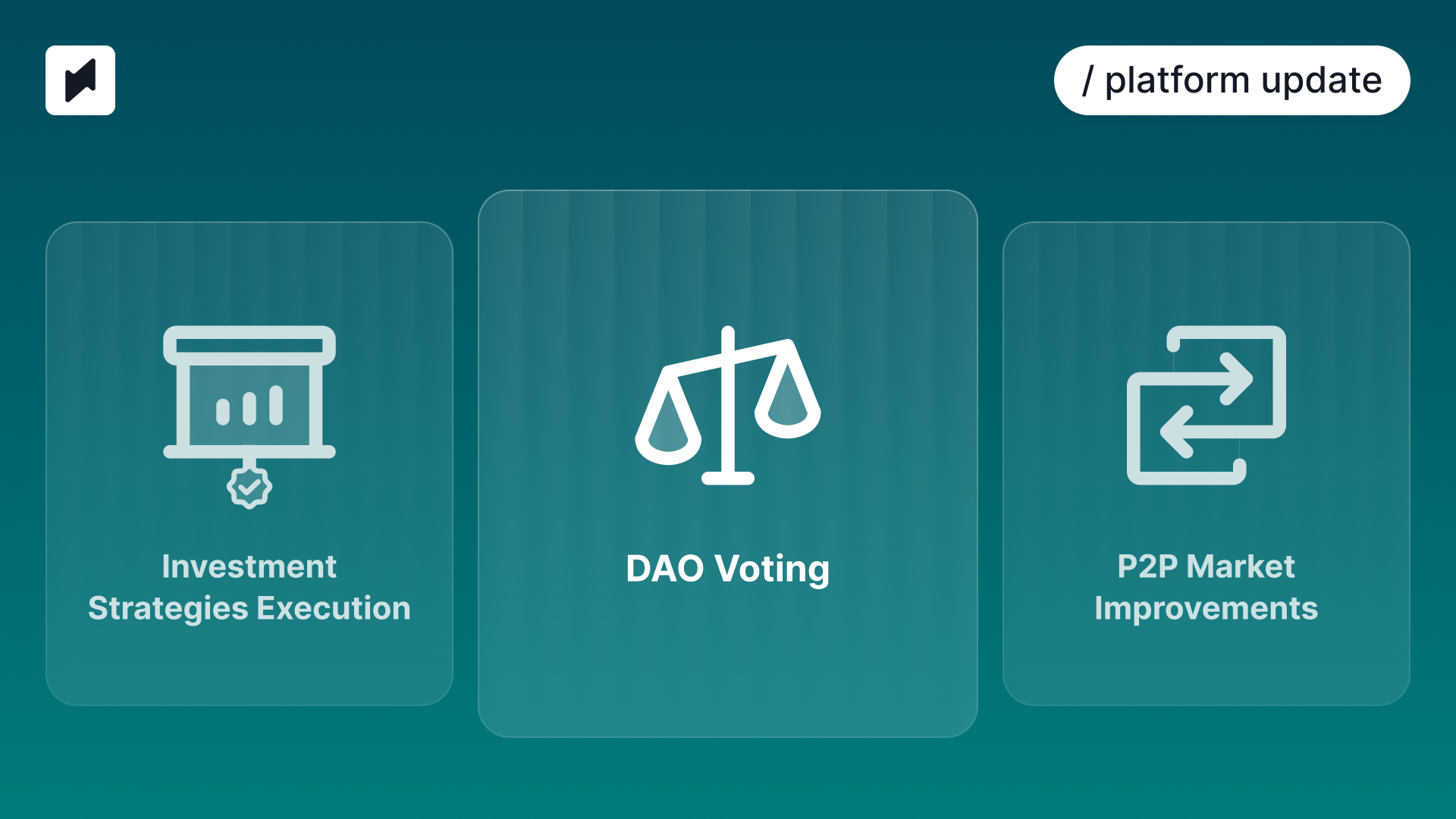As we at the Binaryx platform expand our real estate offerings beyond Bali, you, as an investor, may face a challenge: continuing to invest in the well-known market of Bali or exploring the new opportunities presented by Montenegro. Both locations offer unique advantages and challenges, making a thorough comparison essential. This article will delve into the key aspects of real estate investment in both destinations, providing you with a clear, research-based understanding of the differences between investing in Bali real estate and Montenegro real estate.

If you've ever invested in Bali real estate on our platform, you’ve probably pictured yourself walking along Bali's lush, sandy beaches among palm trees with volcanoes in the background. Now it’s time for another dream. Imagine yourself strolling through the cobblestone streets of Montenegro's old coastal towns, where the Adriatic Sea sparkles under the Mediterranean sun. Picture breathtaking views of the rugged mountains meeting the serene waters—a perfect blend of natural beauty and peace of mind.
Features of Land Ownership
In Bali, the system distinguishes between freehold and leasehold models. Freehold ownership is almost exclusively reserved for Indonesian citizens, making it nearly impossible for foreigners to acquire. As a result, most foreign investors opt for leasehold agreements, which typically last for 25–35 years with the possibility of further extension. While Bali's real estate prices have been steadily increasing, properties nearing the end of their lease terms can become more challenging to resell due to the additional cost of renewing the lease. These specifics can impact future profitability, even if you invest in tokenized real estate and acquire fractional ownership.
In contrast, Montenegro offers a more straightforward and foreign investor-friendly approach to land ownership. There is no division between freehold and leasehold; instead, Montenegro follows the European legal system that provides full ownership and equal opportunities for both local and foreign investors. So, the land under real estate units is typically acquired as full ownership alongside the underlying buildings. Furthermore, every real estate agreement in Montenegro is certified by a notary and registered in the central cadastre, which ensures transparency and legal security for investors. This absence of ownership barriers and the assurance of full property rights make Montenegro an attractive destination for real estate investment, whether it’s full or fractional ownership.
Market Growth Potential
In Bali, the real estate market has become increasingly competitive due to the constantly increasing number of developers and new properties. This surge in development, coupled with a tourist boom, has led to high yields that are expected to continue for some time. However, there is a growing sentiment among real estate experts that the market may soon stabilize and reach a plateau, potentially resulting in decreased yields. Currently, rental yields are reported to be lower than they were a year ago. You can learn more about the Bali real estate market outlook in this article.
Montenegro's tourism sector has gained notable popularity, experiencing a 7% increase in tourist arrivals year-on-year in June 2024, with foreign visitors comprising 90.27%, primarily from Serbia, France, and the UK. Budva remains the most popular destination, drawing 40.2% of tourists. The annual tourist numbers in Montenegro have nearly doubled over the past decade, increasing from 1.2 million in 2013 to 2.4 million in 2023.

In the last two years, Montenegro's appeal has extended beyond tourism, attracting a diverse range of international long-term residents due to its simple residency procedures and low cost of living. This demographic shift is having a significant impact on the real estate market.
In Montenegro, the Residential Real Estate market is estimated to reach US$18.16 billion by 2024 and is projected to grow at an annual rate of 6.41%, reaching US$24.78 billion by 2029. Furthermore, Montenegro is on the verge of joining the European Union, a significant milestone that is expected to further enhance its market potential to the values yet to be discovered. You can learn more about the Montenegro real estate market outlook in our new article.

Seasonality and Occupancy Rate
Bali offers a significant advantage when it comes to seasonality and occupancy rates. The island's tropical climate remains virtually unchanged throughout the year, resulting in consistently high occupancy rates for rental properties. This stable weather pattern allows Bali to maintain an occupancy rate of over 80% year-round, ensuring a steady stream of rental income for property investors. In popular tourist areas, such as Canggu, occupancy rates can reach 90%.
In contrast, Montenegro experiences noticeable seasonality, particularly along its Adriatic coast. The majority of tourists flock to the coastal regions during the summer months, leading to high occupancy rates during this period, but as winter comes, the demand for beachfront properties decreases. You can observe seasonality in Montenegro by checking the chart below.

Nevertheless, this demand decrease does not apply to all regions of Montenegro. The mountainous areas in the north, especially around the town of Kolasin, experience a different pattern. These areas remain popular during the cold season thanks to the numerous winter activities and ski resorts available. For example, our latest Mountain Retreat project in the Belasica Mountains near Kolasin attracts various groups of tourists seeking different experiences throughout the year. In summer, spring, and autumn, visitors come to enjoy the cool, natural surroundings, while in winter, the same area becomes a hub for skiing and other winter sports. Consequently, properties in such areas are expected to have a constant influx of tourists throughout the year, offering a balanced occupancy rate despite the overall seasonal trends in the country.
Construction Quality

In Bali, the tropical climate with high humidity and heat leads to faster deterioration of buildings, as materials like wood are prone to rotting. This accelerated wear and tear leads to more frequent renovations, impacting long-term profitability. Moreover, these climatic conditions often result in the use of lower-quality construction materials, because developers get used to frequent renovations or complete reconstructions. High demand for properties has also led to fast building, often at the expense of quality, as developers compete with each other. While the situation can vary significantly depending on the builder, the lack of construction quality is a common issue in the Balinese market. At Binaryx, we place special emphasis on selecting reputable developers to mitigate these risks.
In contrast, Montenegro benefits from a more temperate climate. The milder conditions mean buildings do not face the same level of wear and tear as those in tropical regions, leading to longer-lasting properties. Additionally, despite not being an EU member yet, Montenegro strives to align its construction standards with those of the European Union. The adherence to high standards and less competitive rush ensure that construction quality is generally superior. Consequently, investment properties in Montenegro are likely to have greater longevity and require fewer renovations over time, making them a more reliable long-term investment compared to properties in Bali.
Nature Diversity and Attractions
Bali, a tropical island, is known for its lush landscapes with forested volcanoes, terraced rice paddies, pristine beaches, and vibrant coral reefs. While different parts of the island offer unique features, the overall tropical climate across Bali limits the natural diversity. The island is famous for its numerous temples and yoga centers, as well as its lively bars and nightlife, making it a haven for tourists seeking both relaxation and entertainment.
Montenegro, on the other hand, is a country of striking contrasts. Nearly three times the size of Bali, Montenegro offers a wider range of climatic conditions and natural landscapes. The coastal regions enjoy a typical Mediterranean climate, perfect for summer tourism, while the mountainous areas experience a mountain climate with cool summers and snowy winters, ideal for winter sports. The attractions in Montenegro are as diverse as its climate. The coast offers charming old towns with typical Mediterranean architecture, giving a glimpse into the region's rich history and culture. The country’s interior is full of majestic mountain ranges, serene rivers, and picturesque lakes. National parks like Durmitor and Biogradska Gora feature virgin forests and pristine air, providing a haven for nature lovers and outdoor activities, such as horseback riding, biking, hiking, and rafting.
Profitability
Bali is a highly sought-after location with immense demand for real estate. This high demand means that local developers typically don’t offer any profitability guarantees because there is no need for them; the profitability of Bali real estate is already well above average and speaks for itself. However, this high demand also involves certain risks. Unpredictable events, or "black swans," can significantly impact the market. The COVID-19 pandemic is a prime example. When the authorities closed Bali to tourists at the beginning of the epidemic, the entire rental market collapsed. While such events are rare and unlikely to happen again soon, there are no guarantees in our lives.
In contrast, Montenegro's real estate market is not overheated, which results in more moderate profitability. This allows for better forecasting of returns, offering a more stable investment landscape. If actual returns differ from forecasts, it is often for the better, as the market is still in a growth phase. Additionally, some developers in Montenegro offer guaranteed returns, providing additional security for investors. For instance, in our latest property project, Mountain Retreat, developer Dukley guarantees an 8% annual return on rent for three years. Check out the deal.
Conclusion
The decision between investing in real estate in Bali or Montenegro depends on various factors that cater to different investor profiles and risk appetites. Bali presents a well-established market with high current yields, consistent year-round occupancy, and a familiar investment landscape for those already engaged in its market. However, the limitations on land ownership, construction quality, and potential market saturation may significantly impact long-term returns. On the other hand, Montenegro offers an emerging market with longer growth potential, full land ownership rights for foreigners, and a diverse range of natural attractions that cater to both summer and winter tourism. The promise of EU accession and guaranteed returns from certain developers add further appeal for those who seek stability and better future appreciation.
However, the best strategic approach is investing in both Bali and Montenegro. By spreading investments across those two markets, you can benefit from the high current yields in Bali and the strong growth potential in Montenegro and create a balanced and resilient real estate portfolio.
Articles you may be interested in





.jpeg)




-min.jpeg)



.webp)